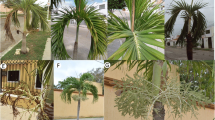Abstract
The presence of phytoplasmas in Lilium sp. showing severely stunted growth, leaf malformation and flower buds deficiency was demonstrated for the first time using polymerase chain reaction assays with primers amplifying phytoplasma 16S rDNA regions. These phytoplasmas were found in leaves as well as roots and bulb scales of symptomatic and CMV and/or LSV affected and asymptomatic virus-free lilies.
Similar content being viewed by others
References
Ahrens U., Seemüller E. 1992. Detection of DNA of plant pathogenic mycoplasmalike organisms by a polymerase chain reaction that amplifies a sequence of the 16S rRNA gene. Phytopathology 82: 828–832.
Asjes C.J., Vos N.P. de, Slogteren D.H.M. van. 1973. Brown ring formation and streak mottle, two distinct syndromes in lilies associated with complex infections of lily symptomless virus and tulip breaking. Neth. J. Plant Pathol. 79: 23–25.
Bertaccini A., Marani F. 1982. Electron microscopy of two viruses and mycoplasma-like organisms in lilies with deformed flowers. Phytopath. Medit. 21: 8–14.
Bertaccini A., Davis R.E., Hammond R.W., Vibio M., Bellardi M.G., Lee I.M. 1992. Sensitive detection of mycoplasmalike organisms in field-collected and in vitro propagated plants of Brassica, Hydrangea and Chrysanthemum by polymerase chain reaction. Ann. Appl. Biol. 121: 593–599.
Bertaccini A., Vibio M., Bellardi M.G. 1994. Impiego di PCR per l’individuazione di micoplasmi in cormi di gladiolo. Informatore Fitopatologico 10: 34–36.
Bertaccini A., Mittempergher L., Vibio M. 1996. Identification of phytoplasmas associated with a decline of European hackberry (Celtis australis). Ann. Appl. Biol. 128: 245–253.
Bertaccini A., Vibio M., Bellardi M.G., Danielli A. 1996a. Identification of phytoplasmas in Alstroemeria. Acta Hortic. 432: 312–319.
Derks A.F.L.M., Lemmers M.E.C., Gemen B.A. van. 1994. Lily mottle virus in lilies: characterization, strains and its differentiation from tulip breaking virus. Acta Hortic. 377: 281–288.
Kamińska M. 1996. Virus infection of lilies in Poland. Phytopathol. Polonica 11: 51–58.
Kamińska M., Malinowski T., Komorowska B., Rudzińska-Langwald A. 1996. Etiology of yellows and witches’ broom symptoms in some ornamental plants. Acta Hortic. 432: 96–106.
Kirkpatrick B.C., Fisher G.A., Purcell A.H. 1990. Epidemiological and phylogenetic studies on western X-disease mycoplasmalike organisms. In: Recent Advances in Mycoplasmology, International Journal Medical Microbiology. Series A, Supplement 20. Eds G. Stanek, G.H. Casell, J.G. Tully and R.F. Whitcomb.: 288–297.
Lederer W., Seemüller E. 1991. Occurrence of mycoplasma-like organisms in diseased and non-symptomatic alder trees (Alnus spp.). European Journal of Forest Pathology 21: 90–96.
Schneider B., Ahrens U., Kirkpatrick B.C., Seemüller E. 1993. Classification of plant-pathogenic mycoplasma-like organisms using restriction-site analysis of PCR-amplified 16S rDNA. J. General. Microbiol. 139: 519–527.
Sinclair W.A., Griffiths H.M., Treshow M. 1994. Ash yellows in velvet ash in Zion National Park: high incidence but low impact. Plant Disease 78: 486–490.
Uyemoto J.K., Connel J.H., Hasey J.K., Luhu C.F. 1992. Almond brown line and decline: a new disease probably caused by mycoplasma-like organism. Ann. Appl. Biol. 120: 417–424.
Verhoeven M., Horvat F. 1972. La deformation des fleurs du lis: une grave maladie provoquee par un complexe de virus: methodes d’identification. Ann. Phytopathol. 4: 311–323.
Vibio M., Bertaccini A., Schiliro E., Rapetti S. 1995. Caratterizzazione molecolare di fitoplasmi associati a virescenza in Anemone. Informatore Fitopatologico 9: 60–62.
Author information
Authors and Affiliations
Rights and permissions
About this article
Cite this article
Kamińska, M., Korbin, M., Komorowska, B. et al. Stunting and flower buds deficiency of Lilium sp.: a new phytoplasma associated disease. Acta Physiol Plant 20, 49–53 (1998). https://doi.org/10.1007/s11738-998-0042-0
Received:
Accepted:
Issue Date:
DOI: https://doi.org/10.1007/s11738-998-0042-0




